Lingual Braces vs. Invisalign: Which Is Better?

As modern technology has advanced, so have the opportunities to straighten teeth in a multitude of ways. Because of this, lingual braces and Invisalign have become popular options for orthodontic care due to their discretion and near-invisibility. While lingual braces have brackets and wires attached to the backside of the teeth, Invisalign offers braces-free care with the use of clear, removable aligners. Both options have their pros and cons, and should be chosen upon an individual’s needs and wants. Find out whether lingual braces or Invisalign is the best option for your orthodontic needs with this guide!
What Are Lingual Braces?
Millions of teenagers and adults have braces put on each year, and most pick the traditional metal braces that we’re all so used to seeing. However, traditional braces can be bulky, annoying and embarrassing for teenagers and adults alike, and many patients feel like they’re distracting. Lingual braces are another option for patients who prefer invisible treatment over big, bulky braces, plus they can achieve the same straight, beautiful teeth that other treatments provide. Instead of wearing braces on the outside of teeth, lingual braces attach the brackets and wires to the backside (lingual side) of teeth for an inconspicuous and nearly-invisible treatment. Other than aesthetic concerns, patients opt in for lingual braces as they make it easier to play wind instruments, such as the flute or tuba, and they’re more functional for athletes that play contact sports. However, not every orthodontic office offers lingual braces; orthodontists have to complete specialized training to be able to install lingual braces, so you’ll have to do your research to find out who in your area is qualified to perform treatment.
Additionally, lingual braces can take longer to get used to since they’re on the backside of your teeth, close to your tongue. They can make swallowing more difficult as the tongue can’t thrust between your teeth as easily as it could before. Patients also have to have long enough teeth to provide enough room for the braces to be glued onto them, so children and those with small teeth typically don’t qualify for this type of treatment. Lastly, treatment time is usually longer with lingual braces than traditional braces. The entire process depends on your orthodontist and how well you take care of your teeth during treatment, so treatment time varies from patient to patient.
How Invisalign Works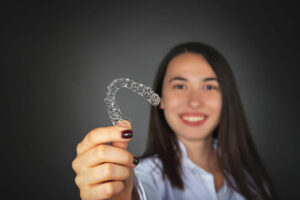
Another option for patients who prefer invisible orthodontic care is Invisalign, which uses clear, removable aligners to fix malocclusion over a period of several months or years. Some patients highly dislike the look of metal braces, lingual or not, and Invisalign offers them the care they need without having to sacrifice their confidence at work or social events. Many enjoy Invisalign because its unique treatment allows them to remove their orthodontic device during eating, drinking, flossing and brushing, making these daily activities much more manageable. They let you eat all of your favorite foods, you can’t break a wire or bracket, oral hygiene isn’t hindered and they’re virtually invisible.
Wearing Invisalign retainers does take time, effort and patience, however. One aligner is worn for one to two weeks before replacing it with the next one in line. You’ll have a checkup every six to eight weeks to monitor your teeth and receive a new batch of aligners to wear for the next several weeks. During this time, Invisalign aligners need to be worn for 20-22 hours of the day, which is a huge commitment for busy people. Aligners also need to be carefully washed and cleaned with a toothbrush each night to keep bacteria from growing. Since they’re removable, Invisalign aligners can be easily lost, misplaced or broken by a fall or child, so extreme care will be necessary to keep them intact.
Making A Choice
Both lingual braces and Invisalign are viable options for patients who want orthodontic care that is undetectable and discreet, but whichever you choose is up to you and your orthodontic needs. The first step that you’ll need to take is to visit with your orthodontist for an evaluation of your teeth and to discuss which of the two would work best for your wants and needs, plus the orthodontist’s recommendation. Remember that while Invisalign is a great option for those who want to take their orthodontic care into their own hands, it requires extreme responsibility and care for the aligners you’ll be using. Lingual braces, on the other hand, will always remain in your mouth, so you won’t need to worry about losing anything like you do with Invisalign, but flossing and brushing can be more difficult as you’ll have to do it all from the backside of your teeth. Your choice should be based on what you are willing and not willing to do during treatment, so do your research on both options to be fully informed on what to expect.
Schedule Your Consultation
To be evaluated for lingual braces or Invisalign, call Belmar Orthodontics at (303) 225-9016 to schedule a consultation. Our team is qualified and experienced at installing both lingual braces and Invisalign, plus we can give you extra tips on how to keep your teeth brilliant and healthy during treatment. Call today to start your journey to a more beautiful smile!
What Foods Should You Eat With Braces?

Whenever you first begin orthodontic treatment, your orthodontist will recommend certain foods that you should avoid, and those which will be good for your teeth. Many times, sugary or sticky foods like candy, gum, corn, and nuts shouldn’t be eaten during the duration of your treatment as they are known to damage braces and increase the likelihood of cavities. While there is a list of foods that you should NOT eat with braces, there are plenty of options that you can still include in your diet that are just as tasty as those that you will have to avoid for a while. Find out what foods you should avoid during orthodontic treatment and what foods you can still enjoy with this guide!
Foods That Are Good
One of the first concerns that patients have as they begin orthodontic treatment involves the food they should and should not eat. A lot of responsibility comes with braces, as you will have to protect them by watching what you eat, cleaning them daily and adhering to your orthodontist’s instructions. To begin, let’s discuss all of the food that you CAN eat during your time with braces. Softer options are your way to go as your mouth gets used to braces, so eating food like chicken, oatmeal, rice, beans, fish, eggs and yogurt are great ways to get a lot of nutrition without breaking a bracket. Even hard fruits, like apples and pears, are good to eat as long as they’re cut into slices or smaller pieces. Don’t think you’ll be able to get away with not eating vegetables during treatment-even the crunchiest of vegetables can be steamed or sliced into slivers, making them perfectly edible for orthodontic patients. You’ll want to eat foods that you don’t need to chew much, especially after an adjustment. Soups and mashed potatoes work perfectly for a sore mouth, and sandwiches and salads (without nuts) can be eaten once you get used to the feel of braces.
Foods To Avoid
Unfortunately, the list for foods that you should avoid during treatment seems to always be much longer than those you should eat. However, the new diet that you’ll be working with for the next several months or years is actually beneficial for you in the long run as most of the food you need to avoid is sugar-filled. Hard and sticky foods are no-nos when it comes to braces; candy, caramel, nuts, chips, licorice, taffy and gum are notorious for breaking wires and brackets, plus they cause cavities. Sugary and starchy foods produce plaque and acid, and the more you eat these foods, the more likely it is that you’ll get tooth decay and gum disease. Hard foods like popcorn and ice can make the impact of braces less effective, meaning a longer treatment time and more money. Additionally, the elastic ligatures that are placed on the bracket itself can be stained by foods with strong colorants, such as berries, grape juice and beets. Even though you may feel like you’re missing out on all of your favorite foods, you’ll be surprised that most foods you love can still be eaten with braces if they’re cut smaller or skinned. You’ll need some creativity when figuring out your meal plan during treatment, but the benefits of keeping your teeth healthy and braces intact outweigh the cons of giving up some of your favorite treats for a while.
Taking Care Of Your Braces
Watching what you eat is just one step in your oral hygiene regimen with braces. First, begin with the basics of brushing and flossing. Take off your elastics and other removable parts of your braces and begin brushing at a 45-degree angle. Clean each tooth and bracket individually in a circular motion, and floss beneath the archwire to remove any leftover food. Flossing can be difficult with braces, so it might be a good idea if you use a floss threader to get in between teeth and under wires. These two steps are essential to thoroughly clean teeth and prevent decay from forming, so make sure that they are a part of your everyday routine. For an additional clean, rinse your mouth with mouthwash to kill bacteria and give yourself fresh breath. Lastly, always go to your orthodontic cleaning and adjustment appointments. The orthodontist will be able to monitor your tooth movement, fix broken brackets, tighten wires, remove plaque and give you pointers on how to take care of your braces.
Get A Beautiful Smile Today
For more information about foods you should and should not eat with braces, call Belmar Orthodontics at (303) 225-9016! Our team has years of experience educating patients on oral health, adjusting brackets and wires and helping patients get the beautiful smiles they deserve. Call today!
Tips For A Tooth-Friendly Independence Day

The Fourth of July offers fun activities full of fireworks, parades and celebrations. From hamburgers to watermelon to all kinds of delicious treats, Independence Day is a fun day for everyone. Amid all the celebrating, though, it’s important that you take care of your teeth by watching what you eat and which activities you participate in, especially when wearing braces. There are lots of food options to choose from, but it’s important to keep your oral hygiene routine in check to prevent tooth decay. Find out how you can enjoy Independence Day and protect your teeth at the same time with these tips!
Commit To A Regular Routine
During this holiday season, our lives go from our normal day-to-day routines to boating, barbecuing and playing with sparklers as we watch the fireworks. The Fourth of July is a week full of festivities that involve a lot of food and fun, but it’s also a time that we easily forget to maintain a good oral hygiene routine. Our daily routine should include how we take care of our mouth and teeth, which means we can’t skimp on brushing and flossing, especially with braces. Plaque loves to sit on teeth as long as it can so that acid can form and eat at your tooth enamel. The longer plaque remains on your teeth, the more likely you are to experience tooth decay. During the week of the Fourth of July, it may be tempting to let your kids skip their normal bedtime routine due to a firework show or a late-night party, but even one night of not brushing and flossing lets harmful bacteria wreak havoc on your child’s teeth. Braces are especially susceptible to the effects of poor oral hygiene as they easily trap food particles around the brackets and underneath the archwire. One tip that can help your kids remember their oral health during the holiday is to keep a brushing calendar. These calendars are simple and easy to use, and they help kids stay on track each day, no matter what busy activity they’re participating in. You can find a brushing calendar at most department stores or you can ask your child’s dentist for one.
Avoid Sugary Foods and Drinks

beautiful blonde child drink water outdoor
One of the biggest mistakes that kids and adults alike make during the Fourth of July involves the type of food that they consume, specifically sugary foods or meals full of starches. It’s hard to resist a juicy burger with a slice of cherry pie, a sugary funnel cake or a cold lemonade, but these holiday foods are full of sugar and starches that not only affect your waistline, but your teeth, as well. Eating lots of foods high in sugar increases your risk of cavities, even if you’re good at brushing your teeth. It’s easy to hand your child a juice box or can of soda while they’re watching the parade, but it’s more beneficial if you offer healthier choices, like water, to keep them cool and hydrated. It’s even better if you can give your child water that contains fluoride, which hardens tooth enamel and safeguards teeth against cavities. For picky kids, milk and fresh juices are also alternatives to sugar-packed sodas and do a good job at protecting teeth. Before all of your fun activities begin, plan out snacks and healthy options for meals that you can provide that will protect kids’ teeth while they’re out having fun. For those with braces, make sure to avoid hard foods like corn on the cob, chips and candy, and don’t forget about sticky foods like caramel, taffy and licorice. Hard and sticky foods are notorious for breaking brackets and wires, which are no fun to deal with on the Fourth of July.
Protect Your Braces
Choosing healthy food options over the holidays is an essential part of protecting braces, brackets and wires. Braces are durable orthodontic appliances, but even they can break from a simple accident, like biting an apple. To maintain the structural integrity of your braces, make sure to brush after each meal (which may be difficult to do when you’re out and about) and use threadable floss to remove pesky food particles from getting stuck. You may even need to use a proxabrush, which is referred to as a “Christmas tree brush” that thoroughly cleans between each bracket whenever normal toothbrushing can’t do the trick. Keeping your teeth and braces clean will prevent tooth decay from developing and will help remind you to watch what you’re eating. Lastly, make sure to schedule regular checkups and cleanings with your orthodontist to remove any plaque that may have built up around your braces and ensure that their functioning correctly.
Schedule A Checkup
At Belmar Orthodontics, we are prepared to help you enjoy this year’s Independence Day by providing dental and orthodontic checkups. Our experienced staff is dedicated to your oral health throughout the entire year, and we can help you and your family receive the beautiful smiles that you deserve. To schedule a checkup or for more tips on how you can protect your family’s teeth this Independence Day, call our office at (303) 225-9016. Your journey to a healthy smile begins today!
Avoiding Sports’ Injuries With Braces

Most orthodontic patients are young adolescents and teenagers, and many of these patients participate in sports that increase their likelihood of having a mouth injury during treatment time. Injuries to the mouth, especially with braces, can be very painful and cause a lot of damage. Protecting your teeth as you play a sport can prevent serious damage and keep your teeth safe. Safety gear, like mouth guards, can protect teeth during a sporting event and prevent costly repairs. Find out how you can protect your child’s teeth with braces with these tips!
Common Mouth Injuries
We’ve all experienced some kind of mouth injury, whether from a fall or getting hit during an athletic event. While not all mouth injuries are severe, even the smallest cut or bruise can be painful, especially when it occurs in the mouth. Trauma to the lips, gums and mouth are common since the tissues are so soft and exposed. Teeth can easily cut the lip or inside of the mouth, and a fall can make you bite your tongue. With braces, mouth injuries can cause even more damage as the appliance itself can get lodged into or cut the cheeks, tongue and gums. Other symptoms include swelling, bruising, bleeding and cuts on the lips and tongue. Since there is a rich supply of blood in the mouth, cuts in the mouth tend to bleed heavily in contrast to other areas of the body. It’s especially important for kids to protect their mouths whenever they have an orthodontic appliance on, because braces, brackets and wires are notorious for breaking and poking into the mouth, causing damage. Using protective gear can protect kids’ teeth and braces from injury without them having to give up the sports and activities that they love.
Importance of Mouth Guards
One of the best tools to use to protect kids’ teeth while playing sports is a mouth guard. In sports like football and boxing, mouth guards are required, but in most other sports it’s purely optional. Sports’ injuries can include chipped or broken teeth, fractured tooth roots and damage to orthodontic appliances, but mouth guards can prevent those injuries from occurring in the first place. Athletes with braces carry a higher risk of experiencing a mouth injury that is extensive and costly. Mouth injuries with braces can knock out or damage several teeth that are adjacent to one another because of the brackets and wires, so using a mouth guard is an essential tool to protect yourself. Mouth guards for braces are typically wider than normal mouth guards so that they can easily cover the braces, teeth and gums while still providing a comfortable fit. For full protection and functionality, the mouth guard should fit well and not impede your breathing. Fortunately, while mouth injuries are expensive to fix, mouth guards are relatively cheap appliances to buy. You can buy over-the-counter mouth guards at nearly every major store, or you can have a custom-made mouth guard from the dentist that is created from a mold to match the impression of your teeth. Mouth guards are preventative measures to protect your child from injuries before they happen, but accidents still occur even if you’ve prepared yourself. If your child has a mouth injury while wearing braces and their teeth or braces were hurt, make sure to schedule a checkup with their orthodontist so that their appliance and mouth can be reviewed for damage.
How To Keep Teeth Healthy
While we can’t always avoid mouth injuries, we can strengthen our teeth by following a few simple rules. Sports aren’t the only way that braces can be damaged; hard candies and foods can cause just as much damage as an injury can. Throughout orthodontic treatment, it’s best for your child to avoid foods like nuts, chips, carrots, ice, gum, caramel and other sticky candies that can break brackets and wires. Brackets are cemented onto the tooth, and whenever they get broken off, it can be extremely painful and cause permanent damage. Your child is also more at risk for cavities whenever they eat these sugary and starchy foods as plaque easily accumulates around the brackets and under the wires. Avoiding these foods in general will prevent the appliances from breaking and decay from forming. Encouraging your child to commit to regularly brushing and flossing their teeth each day will also keep their teeth clean and avoid food particles from getting stuck in their teeth, which can lead to decay. Regular orthodontic checkups will also allow your child’s orthodontist to monitor their teeth movement, recognize any signs of decay and adjust their appliance.
Protecting Your Child’s Oral Health
If your child is involved in sports and has braces, consider having them use a mouth guard. At Belmar Orthodontics, we can advise you on what mouth guards would work best for your child and their activity, plus we can help fit it for them. When it comes to your child’s oral health, the easy way is not always the best way. Protect your child’s teeth from injury by calling our office today at (303) 225-9016 to find out what else you can do to protect your child from mouth injuries!
Perks of Lingual Braces

As modern technology has improved the tools and appliances that are now used in orthodontic offices, there are more options than ever for patients to get straighter teeth without the look of traditional metal braces. Lingual braces are an ideal option for patients who want orthodontic care but in the most discreet way possible. By using a hidden apparatus on the tongue-side of your teeth, you can get straight, beautiful teeth without sacrificing your confidence. Find out what other perks lingual braces have and what treatment looks like with this guide!
What Are Lingual Braces?
Braces have come a long way since they were first invented, and patients have more options than ever to get the straight teeth they want without sacrificing their confidence. Traditionally, metal braces were the most common type of orthodontic appliance used but were bulky and aesthetically not very pleasing. With the modern technology that has been developed during the last few decades, one type of braces in particular has become more and more common. Lingual braces are an alternative to traditional metal braces and provide utmost discretion as they are almost completely hidden. Unlike traditional braces whose brackets are attached to the front of the teeth, lingual braces are attached to the back side (tongue-side) of teeth, making them practically hidden from view. Fortunately, lingual braces can provide the same results as traditional braces but in a manner that is nearly undetectable. These braces are particularly helpful for patients, especially teenagers, who think braces are unattractive or distracting. Now, more than ever, patients can receive the orthodontic treatment they need without putting it off for aesthetic reasons.
How Lingual Braces Differ From Other Options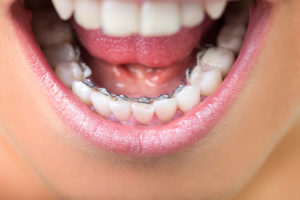
While the obvious advantage of choosing lingual braces over other orthodontic appliances deals with the invisibility of the braces themselves, there are other reasons why lingual braces might be the best option for you. Since their invention in the 1980s, lingual braces have slowly gained recognition as a viable option for orthodontic treatment. In fact, very few dentists even offer this technique because special training is needed to perform it. You will still need X-rays, molds and impressions of your teeth to begin treatment, just like you would when getting any other orthodontic treatment. The process is relatively easy to install them, as the brackets are glued to the lingual side of the teeth with a wire and elastics (if needed) to help move the teeth into position. Lingual braces are always on during treatment, so they are constantly shifting your teeth into the correct position without you or others noticing. A similar treatment to lingual braces is called Invisalign, which uses a removable aligner to straighten teeth. Invisalign is a popular option because the aligner is clear and removable so most people don’t notice it’s there, but not everyone is eligible for Invisalign. While Invisalign is a great option, lingual braces tend to be more helpful for patients with specific concerns. Athletes benefit greatly from lingual braces as it helps prevent mouth injuries since the brackets aren’t on the front of the teeth. Musicians, like those who play a wind instrument (flute, trumpet, clarinet, etc.), are also common wearers of lingual braces as they tend to not get in the way as much when playing. Lastly, those patients who don’t qualify for Invisalign typically choose lingual braces as it is the second most discreet option available. Depending on your needs and your orthodontist’s recommendation, you can choose which option you would like to get the beautiful teeth that you want, in the way that you want.
How To Begin Treatment
As mentioned previously, you must be eligible for certain types of orthodontic treatment to receive them. If you are interested in lingual braces, you will first need to visit with your orthodontist to have a consultation and evaluation to determine whether lingual braces are your best option. If you are a candidate, you will have impressions taken of your teeth which will be sent to a lab to create your custom-made brackets and wires. Afterwards, the brackets and wires will be bonded to your teeth to begin treatment. It is important to note that while lingual braces are a great way to keep your treatment unnoticed by others, the braces themselves are more difficult to clean since you can’t see them. For this reason, it is extremely important to clean your teeth thoroughly each day because it will be easier for food to get stuck and bacteria to grow in areas that are hard to see or reach. Another reason why it is important to consult with your orthodontist before choosing lingual braces is the price. Traditional braces typically range from $3,000-7,000, but lingual braces can be anywhere from $8,000-10,000. For patients who are on a budget, this is something to consider as you are in the decision-making process. Check with your dental insurance to see how much they can cover for orthodontic treatment. While many plans don’t offer coverage for adults over 18, many do partially cover children under 18. How much coverage will depend on your provider, so make sure to contact your insurance company for figures and amounts before you or your child begins treatment.
Get Started Today
At Belmar Orthodontics, our team is certified and trained for installing lingual braces. We are ready to help you and your family get the smile you deserve in a way that is most comfortable for you. For a consultation about lingual braces or more information about orthodontic treatment options, call our office at (303) 225-9016. Your journey to a healthier smile starts today, so call now!
Common Problems With Braces

As you begin orthodontic treatment, changes will occur in your mouth that could be uncomfortable or unexpected. Braces help patients get the beautiful and straight smiles that they deserve, but orthodontic treatment is not an easy process. As your teeth begin to shift, you can experience some tooth tenderness, lip sores, or pokey wires. These are all normal occurrences, but some patients can feel uneasy. Regular orthodontic visits can remedy these situations and help you feel back to normal in no time. Find out what to expect with braces and how you can treat these issues!
Problems That Braces Can Cause
As you begin orthodontic care, there are some problems to look out for that are commonly associated with braces. Although most of these issues are not serious, it is still good to know what to expect whenever you begin care. Once braces are placed, the process of fixing your malocclusion begins and your teeth will start to shift into their correct positions. As this occurs, soreness and swollen gums are both very common reactions to braces. Swollen gums can also influence tooth tenderness, which normally lasts between 2-4 days after braces are first placed. Dull aches can also accompany tooth tenderness but can be relieved by eating soft foods and an over-the-counter pain medication, if needed. Other common problems with braces include lip and cheek sores, pokey wires, and loose bands and/or brackets. Lip and cheek sores develop as the brackets rub against your mouth but can be remedied by placing a small piece of wax on the part of the braces that’s causing the irritation. Pokey wires can be caused by sticky foods or when a patient picks at their braces, and wax can also be used to cover the pokey piece or you can try pushing the wire back into place with a Q-tip or pencil eraser. Loose or broken bands and brackets normally aren’t considered an emergency and can be covered in wax until the next orthodontic appointment. If the broken bracket holds a rubber band in place or if a bracket on one of the upper or lower front teeth breaks, you will need an appointment as soon as possible to fix the bracket.
Serious problems that can be caused by braces include demineralization and gingivitis. Demineralization creates white scars that look like tiny white boxes and outline the area where the bracket used to be. These white scars are caused as food left on teeth come in contact with bacteria and create acid. The acid destroys calcium and phosphate in the teeth, which causes decalcification or white scars. Braces do not cause demineralization, but bad hygiene during treatment usually leads to white scars. Unfortunately, white scars normally don’t disappear after braces are removed and can even lead to cavities. Gingivitis, on the other hand, occurs as the gum tissues become inflamed and is one of the first steps to gum disease. Redness, swelling, tenderness and bleeding can result from gingivitis, but can be entirely prevented by brushing rigorously around the brackets and flossing regularly.
Importance of Good Oral Hygiene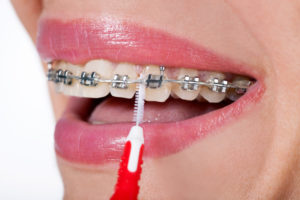
Many problems that come with braces can be avoided or lessened by sticking to a strict oral hygiene regimen. To properly maintain your braces, make sure to brush after every meal, use threadable floss or a floss threader and use a proxabrush. Even though it may seem excessive to brush after each meal, this practice can get rid of remaining food that may be stuck in your braces and prevent plaque and acid from building up (which helps prevent demineralization and gingivitis). Floss threaders are placed between the teeth and under the wire to aid in flossing. Threaders help you floss between each tooth, which can be difficult to do with braces in the way. A proxabrush is typically referred to as a “Christmas tree brush” and helps clean between each bracket. By placing the proxabrush under the archwire and between each bracket, you can thoroughly clean the bracket and remove any stuck food particles.
Maintaining a good diet, especially during orthodontic care, should be another important part of your oral health routine. Sticky or hard foods, such as nuts, popcorn, gum, caramel and chips, can damage your orthodontic appliance and hurt your teeth. Although the temptation may be great to cheat and eat one of these items, the consequence of doing so can be costly and painful. Eating these foods also gives you a higher risk of developing cavities during your time with braces, which can be difficult to treat. Make a list of the foods you should and should not eat, and stick to your oral health goals to keep your teeth and braces healthy.
Starting Orthodontic Care On The Right Foot
If you or a member of your family is in need of orthodontic care, call Belmar Orthodontics at (303) 225-9016! Our dedicated staff is ready to help you achieve your oral health goals and get a beautiful, straight smile. Call now to find out what options we have for braces and how soon you can begin treatment!
Why Is Orthodontic Care So Important?

Many patients receive orthodontic care during childhood or early adolescence. As modern technology has advanced, so has the need for orthodontic care in patients of all ages. Whether your symptoms are severe or not, orthodontic care can help monitor face and jaw development, reduce the risk of impacted teeth and correct life-time dental issues. Early detection and treatment are essential for good oral health and maintaining a beautiful smile. No matter what your age is, find out how orthodontic care can benefit you now and what effects it can have on you in the future with this guide!
Benefits of Orthodontics
Just like any other product you buy or activity that you participate in, orthodontics is an investment. It is an investment of time, money and patience, but the results can be life-changing. There are a variety of options to choose from when receiving orthodontic care, and many are so discreet that you hardly even notice that they’re there. Orthodontic treatment helps establish good oral health and can pave the way for a healthy smile now and in the future. A healthy bite and a good-looking smile is just as important at age 60 as it is at 16, and orthodontic treatment is the way that you can ensure that you have both. For kids, some benefits of early orthodontics include:
- Observe the progress of incoming teeth
- Guide teeth into their ideal positions
- Monitor face and jaw development
- Reduce the risk of impacted teeth
- Detect hidden dental issues
As technological advances in dental science has improved, there are more options than ever for adults seeking orthodontic treatment. Many times, adults have been struggling with specific orthodontic issues since childhood that have never been resolved, but orthodontic care can fix that. Even though orthodontic treatment is most successful during adolescence as teeth and jaw bones are still developing, adults can still enjoy improvements to their oral health with orthodontic treatment at any age. Whether it be traditional metal brackets or other discreet options, like Invisalign, there are plenty of ways to straighten teeth. Some of the many benefits that adult orthodontics provide include:
- Faster treatment time than former orthodontic techniques
- Correction of life-time dental problems
- More discreet treatment methods
- Increased self-esteem and confidence
When To See An Orthodontist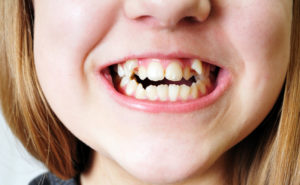
The American Association of Orthodontics recommends that children have their first orthodontic visit by age 7 or 8 to prevent the progression of any orthodontic issues that may be present. Even if you do not detect any dental issues with your child, it is still important that they get evaluated early on so that their teeth and jaw development can be properly monitored. If you notice that your child has bite problems or protruding teeth, it is time for them to see an orthodontist. Bite problems, such as a crossbite, cause the jaws to develop unevenly, while protruding teeth can be fractured or injured much easier than normal teeth. For both children and adults, there are certain signs that you should look out for that may necessitate an orthodontic visit. Some of these symptoms include difficulty chewing or biting, jaws that shift or make sounds, grinding/clenching teeth, biting the cheek or roof of the mouth, protruding teeth, and facial imbalance or asymmetry (facial features out of proportion). Even oral habits, such as thumb-sucking, affect how the mouth develops and can necessitate orthodontic treatment. For many patients, orthodontic treatment isn’t necessarily needed but is wanted to improve self-confidence and give them a prettier smile. Whatever your reason is, orthodontic care can help you reach your goals and improve your oral health at any stage in life.
How You Can Start
After you make the decision to begin orthodontic treatment for yourself or your child, the first thing to do is schedule an appointment with your orthodontist for a consultation. This consultation will allow both of you to establish appropriate goals, address concerns and develop a treatment plan. Additionally, taking good care of your teeth at home by maintaining an oral health regimen is important to keep your teeth healthy and prepare them for orthodontic treatment. Consistent brushing and flossing each day will protect your teeth and gums from plaque, tooth decay and cavities. During orthodontic treatment, it’s essential to maintain this routine to avoid any complications from occurring, which can extend treatment time and be costly to fix.
If you have questions regarding orthodontic treatment for yourself or your child, call Belmar Orthodontics at (303) 225-9016! Our talented staff is dedicated to you and your oral health goals, and will strive to help you get the beautiful smile that you deserve!
Teeth Cleaning Habits To Have With Braces

Good oral hygiene is one of the most important goals that we should all have to maintain the health and strength of our teeth and gums. Once we get braces, however, our oral hygiene regimen will change to account for the new appliance in our mouths that we will have to clean around. Whether you have traditional braces or lingual braces, cleaning around the brackets and wires is essential in preventing cavities and tooth decay. There are many options to choose from to clean between teeth, such as a proxabrush, and other tools to thoroughly brush around the brackets, such as an electric toothbrush. Find out what all you can do to keep your smile healthy and bright with braces with these tips!
Extra Care For Teeth During Orthodontic Treatment
Orthodontic care is one of the most helpful and important dental treatments that patients have readily available to them. While there are many versions of braces that help straighten our teeth and fix misaligned bites, there are certain precautions that we need to take to ensure proper care for our orthodontic appliances and teeth. Brackets and wires in the mouth make it easier for food particles to get stuck in, which can lead to dental problems, like cavities. Proper oral hygiene is essential during your time with braces to avoid any preventable issues that can lengthen your treatment time or need special care to be fixed.
Since braces naturally create nooks and crannies where bacteria can hide, it is important to maintain a good oral hygiene regimen everyday so that you can avoid tooth decay and gum problems during orthodontic treatment. If teeth and brackets are not kept clean, permanent damage can occur to the tooth enamel, as well. When this occurs, white spots (tooth decay) can begin appearing on the teeth where the enamel surface has lost minerals, which cannot be reversed. Bleeding or inflamed gums, called gingivitis, is also common whenever patients don’t clean their teeth thoroughly enough with braces, and it can be very painful. While it is not likely that all of these issues will occur if you miss brushing your teeth or flossing well a few times, you will be more prone to an increased risk, which will hurt your oral health and complicate the rest of your orthodontic care.
Teeth Cleaning Options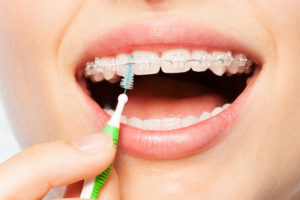
Although cleaning your teeth with braces isn’t too difficult of a process for most patients, there are some tools that you can use to better clean around the hard-to-reach areas in your mouth and make your time cleaning more efficient. First and foremost, make sure that you (or your child) are brushing after each meal. It may seem insignificant, but brushing after you eat removes food particles that are stuck in braces, reduces staining and prevents bacteria buildup. Secondly, use a threadable floss or floss threader to clean underneath the wire of your braces. A floss threader works by inserting the pointed end between the teeth and under the archwire. From there, move it back and forth until it is able to thread the floss between the teeth. Then, you can floss the two teeth, on either side, to remove all food that may be stuck there. If you’re having trouble with your floss getting stuck, consider using waxed floss, which slides between the teeth easier and doesn’t get snagged.
After brushing and flossing, using a proxabrush is helpful in cleaning between each bracket. Commonly referred to as an interproximal brush or “Christmas tree brush,” a proxabrush is placed between two brackets, below the archwire, and uses an up-and-down motion to remove any lodged food particles that brushing and flossing can’t get to. Clean the brackets with the proxabrush on both sides, starting either up from the bottom or down from the top, and repeat between each tooth. Another option for hard-to-reach areas is an oral irrigator, which uses a pulsating stream of water to remove plaque and food debris. Mouthwash is also a helpful tool to kill and bacteria that may have been left after brushing and flossing. For an extra clean, try using an electric toothbrush to maximize cleaning and brush those difficult areas of the mouth that are hard to reach.
Braces-Friendly Diet
The foods we eat and the diet we have affect our oral health and can interfere with orthodontic appliances. Eating sugary or starchy foods can let plaque develop around the brackets, which can lead to cavities, staining or even gum disease. Sticky or chewy foods, such as caramel, taffy, chewing gum and corn on the cob, should also be avoided as they can easily become stuck between brackets and be difficult to remove. Hard foods, such as candy, beef jerky, nuts and popcorn, are also no-nos as they are known to break wires and loosen brackets. If you’re going to eat hard or crunchy foods, such as apples or carrots, make sure to cut them into small, bite-sized pieces to avoid any possible damage.
Regular Orthodontic Checkups
Even if you or your child are following these rules, it is essential that you visit with your orthodontist regularly so that they can monitor teeth movement and adjust any wires or brackets. Your orthodontist or hygienist can show you how to use the tools previously described and give you additional teeth cleaning supplies to aid you during treatment. For more questions about how to clean your teeth with braces or what foods to stay away from, contact Belmar Orthodontics at (303) 225-9016!
Whitening Teeth With Braces
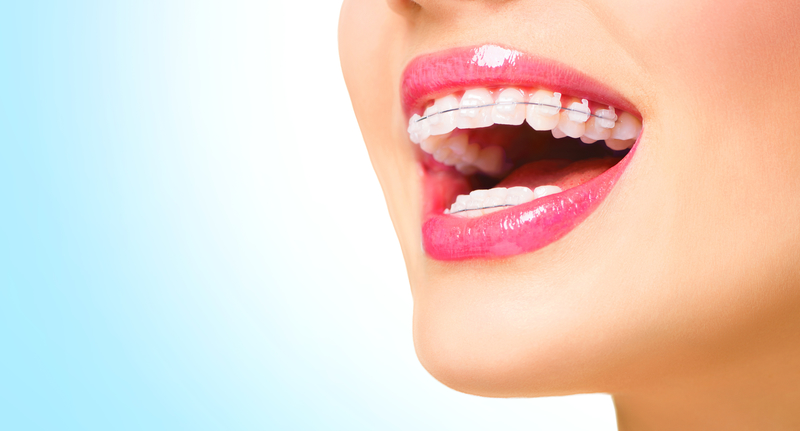
Keeping teeth clean during braces is an important part of your oral health regimen, but keeping teeth white with braces sometimes presents a problem. Teeth whitening with braces is a common practice that orthodontic patients have done to keep their teeth white during orthodontic care. Which teeth whitening treatment you use will depend on what type of braces you have. Achieving a whiter smile is not impossible with braces, but will need extra effort and care to protect your braces. Find out how you can both whiten and straighten your teeth at the same time with these tips and tricks!
In-Office versus At-Home Treatments
Teeth whitening has been a popular choice of treatment for dental patients for years now, but orthodontic patients can now receive the same treatment, too, while getting their teeth straightened at the same time. Keeping your teeth clean while undergoing orthodontic treatment is an important step in maintaining good oral health, and teeth whitening options can enhance that process. With the variety of treatment options that orthodontic patients now have to straighten their teeth, there are plenty of ways to whiten teeth while receiving care. For patients who prefer whitening their teeth at the dental office, one option that patients can choose is “chairside bleaching.” This process requires one or two office visits in which a strong bleaching agent is applied to the teeth combined with a special light to accelerate the whitening effect and lift stains. For patients with brackets on the front of their teeth, chairside bleaching can cause a two-tone effect after traditional braces are removed, so sometimes it is best to bleach after your treatment is over. For patients with lingual braces (on the backside of teeth), though, it is relatively easy to whiten teeth during treatment since teeth whitening focuses on the front of the teeth and not the back. Removable braces and retainers also allow for successful teeth whitening as they allow all of the teeth to be uncovered.
Many patients prefer at-home teeth whitening treatments over in-office treatments because it allows them the flexibility to decide when and where they whiten their teeth. For at-home treatments, gel similar to those used in dental offices will be given to you that is inserted into a customized tray which is fit to your mouth. The gel uses peroxide to bleach the tooth enamel and whiten the tooth. Even those with braces can use these custom trays after braces have been placed in the mouth. The trays have to account for the space that brackets use so the gel doesn’t displace the bracket from the tooth. With at-home treatments, though, there is a larger risk of sensitivity and gum irritation if bleaching material leaks out of the tray. Both options for teeth whitening allow patients the freedom to get the best results during their orthodontic treatment but still get the same benefits that braces offer.
Things To Consider
When deciding on which type of teeth whitening you should do, it is important to remember that the type of braces you have dictates what kind of teeth whitening you can receive. As teeth shift during orthodontic treatment, tooth sensitivity and gum irritation can increase when using mouth trays or teeth whitening strips at home. Traditional braces use brackets on the front side of the teeth to correct malocclusion while other options, like lingual braces, use brackets on the backside of teeth to straighten teeth. Whitening teeth with lingual or removable braces is much easier for patients than those with traditional braces as brackets prevent a good portion of the tooth from bleaching agents. For this reason, most orthodontists recommend using teeth whitening products once braces are removed for most effectiveness. If you do choose to use teeth whitener during treatment with traditional braces and you feel some sensitivity/tenderness, make sure to avoid whitening for a while to give your teeth a break. Chewing gum can also help with any pain you might feel from whitening agents, as well as using sensitivity toothpaste. For additional insights into what to expect when using teeth whitener with braces, meet with your orthodontist to discuss which option is best for your mouth.
Everyday Teeth Whitening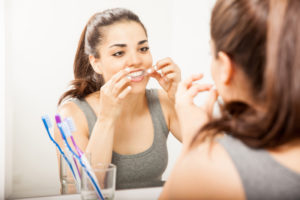
Many patients use everyday teeth whitening products to improve their smile rather than going to a dental office or using expensive products. As teeth whitening has become more popular, more and more products have been created to enhance smiles in the comfort of one’s home with a smaller price tag than traditional methods. For anyone, with or without braces, using a teeth whitening toothpaste is a great and easy way to whiten your smile and maintain good oral health at the same time. Even if you have sensitive teeth, there are still plenty of options for toothpaste that whiten teeth without putting your sensitive mouth at risk. There is also teeth whitening mouthwash that whitens and protects teeth from stains while freshening your breath at the same time. Switching from a manual to electric toothbrush can further whiten your teeth by polishing away surface stains that appear under braces. With all of the different dental items that can be tailored to your individual needs, you can have a whiter smile with braces in no time.
For more information on how you can whiten your teeth during orthodontic treatment, call Belmar Orthodontics at (303) 225-9016! Our team is committed to helping you and your family get the healthiest and brightest smile possible!
The Impact Of Straight Teeth On Oral Health
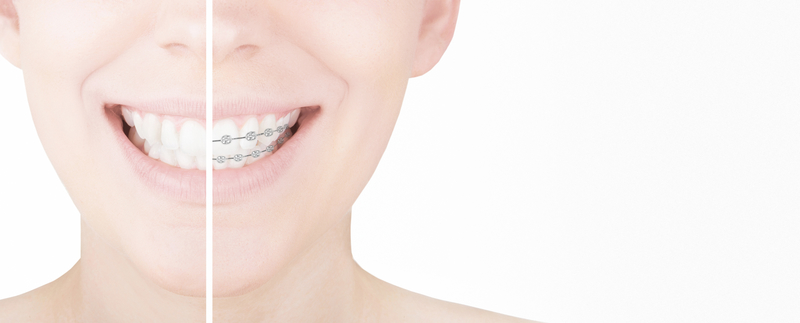
Many orthodontic patients use braces so that they can have straight teeth, but that’s not the only reason why orthodontic care is so important. Having straight teeth can minimize the likelihood of tooth decay and tooth loss while improving your bite, which affects your ability to chew and speak. Correcting crooked teeth can also improve your oral hygiene and strengthen teeth. Learn more about the positive effects that straight teeth can have on your oral health through this guide!
How Straight Teeth Can Help You
One of the main goals of braces is to create a straight smile and correct any orthodontic issues that may prevent teeth from remaining straight. While orthodontics does focus on straightening patients’ teeth, this is not the only purpose of receiving orthodontic care. Whenever a patient has malocclusion, or bad bite, caused by crowded or crooked teeth, daily oral hygiene can become a difficult task. Malocclusion can also stem from teeth that are out of alignment, or jaws that do not meet properly. Thumb sucking or accidents to the teeth can also cause malocclusion. As oral hygiene becomes more difficult to maintain, the likelihood of dental complications, such as tooth decay, periodontal disease, and tooth loss, increases. An improper bite that goes unaddressed can negatively affect chewing and speaking, and wear down tooth enamel. Correcting these problems is of utmost importance to your orthodontist as they seek to give you the best care possible. Orthodontic care that helps straighten teeth can decrease and ultimately eliminate the chances of any of these complications from arising. With straight teeth, patients can better brush and floss their teeth, which will help strengthen them, while easily monitoring any changes that may occur.
What To Expect With Orthodontics
As you begin your orthodontic treatment, there are a few tips that you should know to prepare yourself for what will be expected of you during your time with braces. Although there are some challenges with straightening adult teeth versus children’s teeth due to the pliability of the jawbone, modern technology allows any adult of any age the opportunity to correct crooked teeth with remarkable success. You will first meet with an orthodontist for an evaluation and orthodontics consultation to determine what option is best for your mouth. Any oral health issues, such as gum disease, will have to be resolved before you can begin treatment. Adults have a variety of options to choose from for their orthodontic care, with many discreet options, such as ceramic or clear braces, lingual braces, and Invisalign clear removable retainers, that are available for your needs.
For children, treatment is similar to that of adults and can start as early as the age of 7. Having an orthodontic examination early on can prevent the progression of orthodontic issues that are present and allow the orthodontist to monitor the development/eruption of teeth. Aesthetically-minded treatment options, such as incognito lingual braces, are available for young children who may be self-conscious about their orthodontic care. Most children and adults can expect treatment for 1-3 years, followed by a period of time in which a retainer will be used to keep teeth in their newly aligned positions. Regular dental and orthodontic visits will be necessary to track the progress of teeth and manage any plaque or tartar buildup that could accrue between teeth.
How To Keep Your Straight Teeth Healthy
Once you or your child finishes orthodontic treatment, it is important to continue certain oral health standards to maintain the health of your gums and teeth. Eating a healthy diet, with or without braces, while limiting the amount of sugary foods you consume, will prevent plaque that can stain or damage your teeth. Brushing with fluoride toothpaste and flossing each day will also prevent any plaque buildup, prevent cavities, and keep your teeth clean. Good oral hygiene is especially important for patients wearing braces because you are more susceptible to plaque buildup around brackets and underneath wires. For additional protection, consider using a mouth guard while playing any sports or activities that could damage your mouth, if hit. Creating a good oral health regimen before you start orthodontic treatment will help you have a healthy mouth during and once braces are removed.
For more information on the importance of straight teeth on oral health and what you can do to get the straight teeth that you want, call Belmar Orthodontics at (303) 225-9016! If you’re ready to change your smile for the better, our team is ready to help you reach that goal for you and the rest of your family!

